A beaver dam blocked spawning salmon at Carkeek Park. Now humans are giving nature a nudge
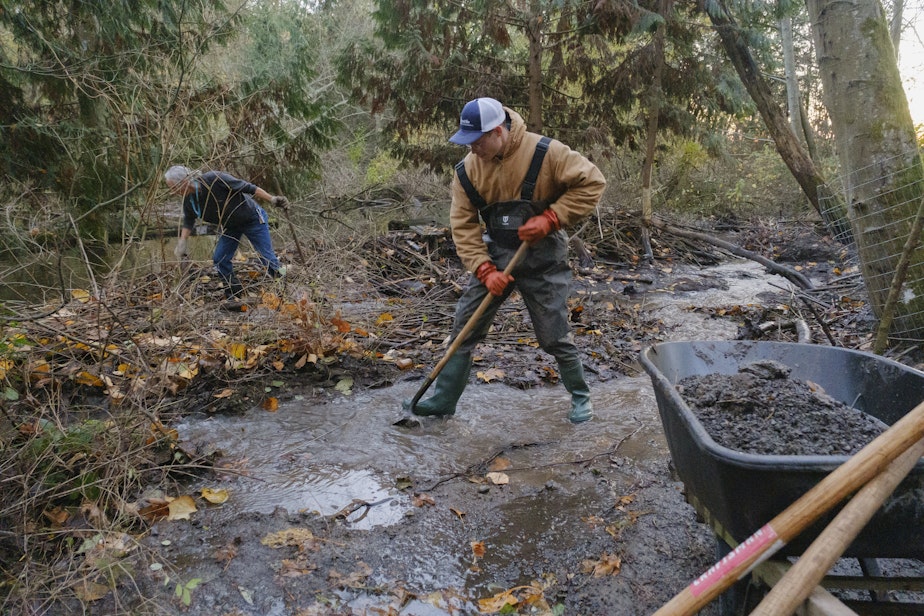
Typically, a major construction project in Seattle requires a city permit. Changes to a park would have you wading into the political process – maybe lobbying your city council member or the mayor.
But beavers can’t be bothered with land use applications.
Starting this spring, a family of the famously busy rodents began terraforming a section of Carkeek Park, in northwest Seattle. The beavers did their beaver jobs: They built dams. The largest of these now stretches an estimated 60 feet across the park’s central ravine, incorporating a park bench, and slowing Piper’s Creek to form a massive, roughly 100-foot wide pond.
The beavers’ mega-dam and the new wetlands it has created is a natural wonder. It’s become a big draw for visitors hoping to catch a glimpse of the buck-toothed engineers responsible. (Beavers are nocturnal – dusk and early morning are your best bets.)
But the dam has also interrupted another remarkable aquatic feat of instinct and perseverance: the annual return of hundreds of salmon from the sea, intent on reproducing in their home waters. Instead of making it upstream to Venema Creek and other areas, the Piper’s Creek salmon were running smack dab into a wall of sticks and mud.
“We did have a bunch of males trying to beat their way through the biggest part of the dam,” said David Koon, salmon program director with the nonprofit Carkeek Watershed Community Action Project (CWCAP). “I don't think they ever got through there, it is so thick.”
Outside of a couple days of heavy rain in early November, “the fish were basically coming up to the dam, stopping and dying,” Koon said. He spoke last week during his rounds as a salmon steward – CWCAP volunteers who answer people’s questions and help educate the public on water quality issues.
Sponsored
The Piper’s Creek salmon run is a popular fall attraction, one of the few places to see salmon spawning in Seattle – the result of decades of habitat restoration efforts by volunteers working with the city, state, and local tribes.
But more than halfway through spawning season, most of the action was limited to a handful of nesting sites in the first 300 feet of freshwater stream between the Puget Sound estuary and the beaver dam, according to results of weekly CWCAP volunteer salmon surveys.
That put extra stress on the short strip of the creek where salmon nesting sites were visible.
“One of the problems with this is now everybody who wants to see the salmon comes down here,” Koon explained, pointing to new unofficial trails branching off the main walkways. “We're having lots of people trampling through the wetland and making social trails.”
Now, after weeks of watching and waiting – and some confusion about the law – Seattle’s parks and rec department has cut a new passage for salmon next to the dam, intended to clear the way to more spawning areas in Carkeek Park.
Sponsored
It’s a win for Koon, who had pushed the city to intervene.
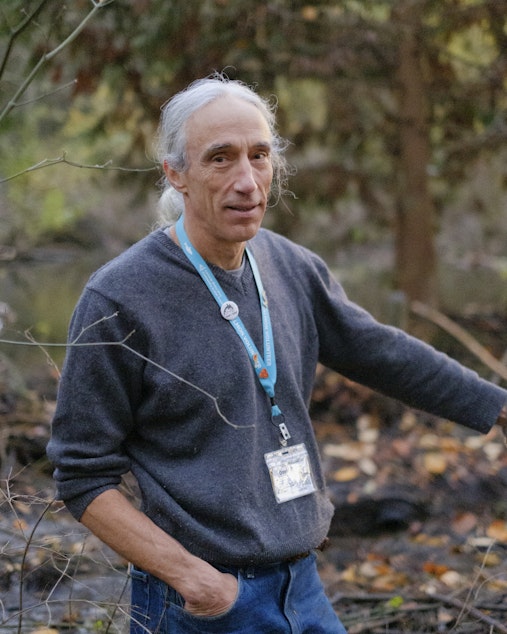
Beavers are common in Washington streams, and salmon coexisted with dams long before humans arrived on the scene.
Koon said he had expected new channels to develop to allow salmon to pass, as Piper’s Creek eroded the surrounding dirt. But this, after all, is a city park – and hard-packed gravel trails weren’t behaving like the soft banks of a creek in the wild.
“The human element here is having the biggest impact,” Koon said. “It’s the human infrastructure causing an impediment. And I think that's what we should be addressing.”
Sponsored
Not everyone agreed. Whether to intervene became a hot topic between the city, volunteers who promote salmon restoration in Carkeek Park, and the Washington State Department of Fish and Wildlife.
In early November, Seattle Parks & Rec provided a statement to KUOW that said the city was watching the situation.
“[O]ur staff is working with the Washington Department of Fish and Wildlife (WDFW) to ensure we manage beavers in accordance with state law, which includes exploring mitigation strategies to help protect the trees, salmon and the salmon run, manage water levels near trails, [and] encourage the beavers to inhabit other park locations or relocation.”
But, the statement added, there was little the city could do, because, “at present, dam modifications and other actions are not allowed by WDFW during the active migration season when adult salmon are present.”
As the month went on, and salmon surveys continued to find zero salmon getting past the beaver dam, Koon pushed harder for action.
Sponsored
“State and parks need to do something soon or we won’t have any more fish going up,” Koon said in a phone call.
It wouldn’t be the first time the Carkeek Park salmon needed a helping hand.
Logging, overfishing, and other human activities around the watershed wiped out this natural salmon run in the early 20th century.
Then, starting in the 1980s, people decided it was time for the salmon to come back.
Today, Piper’s Creek is a human-supported salmon run: In the spring, Koon’s group, the Carkeek Watershed Community Action Project, works with the state and the Suquamish Tribe to raise chum fingerlings in an imprint pond at the park. After a few days of soaking in their surroundings, the tiny fish have learned enough to remember the creek during their years growing big in the North Pacific.
Sponsored
Ultimately, many hone in on the same stream when it’s time to lay eggs, see them fertilized, and die.
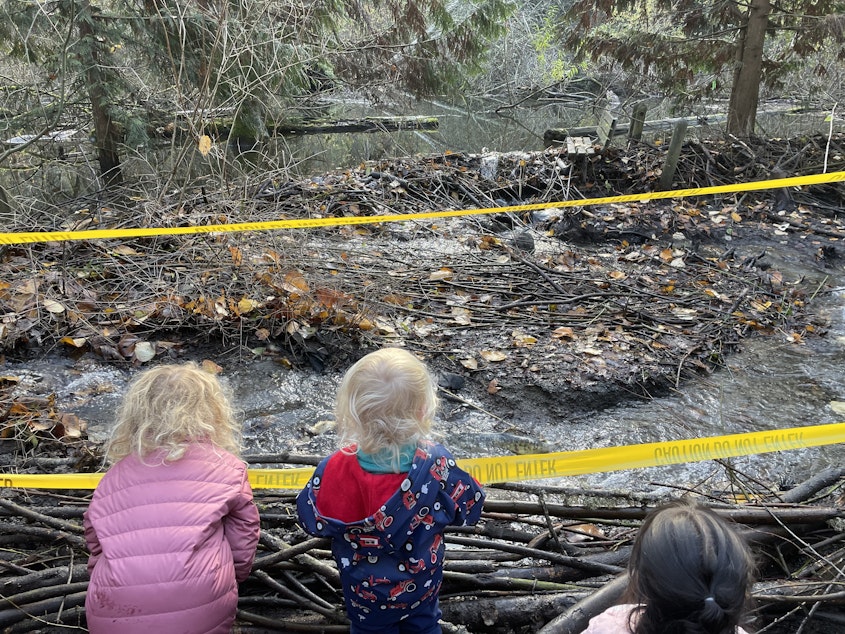
The salmon trying to get past the beaver dam this fall are mostly fish David Koon and his fellow volunteers helped raise in that imprint pond. Few, if any, of the chum fry that naturally hatch in Piper’s Creek survive to mature and spawn.
That’s because most of the surrounding watershed is covered in single-family homes and denser urban development. Water volumes in the creek change rapidly as runoff makes its way at unnatural speeds to Puget Sound. Fast-moving currents scour carefully laid redds, or salmon nests, and carry salmon-choking sediment downstream.
“The importance of the run for us is primarily educational,” Koon explained. “We get to talk to people about watersheds, what they can do in their yards, building rain gardens, and using permeable surfaces for driveways and patios.”
It’s what drives CWCAP volunteers to show up, rain or shine, daily to Carkeek Park during salmon spawning season – answering countless questions from curious park visitors, and even strapping on fishing waders to search for salmon carcasses, carefully dissecting, cataloging, and replacing their finds.
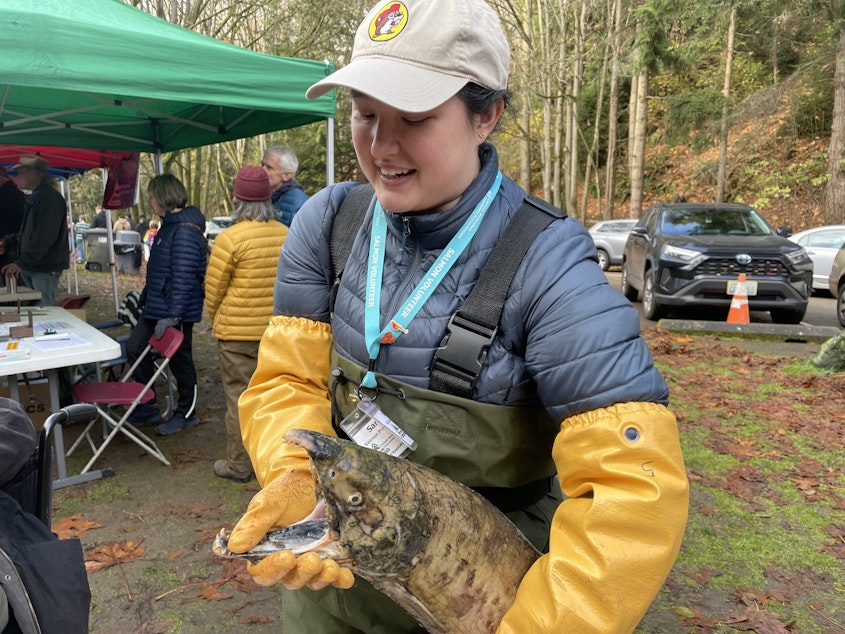
This city is no stranger to beavers on public land.
“Seattle is a hot spot for urban beavers,” said Elyssa Kerr, executive director of Beavers Northwest, which has consulted with Seattle Parks and Rec on the beaver dam at Carkeek Park.
As of 2021, Beavers NW had identified signs of 14 colonies throughout the Seattle area. Kerr’s favorite spots to view beavers in the city include Longfellow Creek in West Seattle, Magnuson Park, and Meadowbrook Pond. The Carkeek beavers likely migrated from a colony in Golden Gardens.
Beavers have recovered in Washington after being trapped to near-extinction in the mid-1800s. Kerr said there’s not a great amount of data on how beavers are doing today in the state, but anecdotally, populations seem to be on the rise in recent years – as her organization has gotten more reports of beavers interacting with humans.
Kerr’s organization advises governments and private landowners on beaver mitigation, say, when flooding becomes a problem. That can include notching the dam or inserting flow devices that allow water to escape when it hits a certain level, limiting the size of the beaver’s pond.
Relocation is an option, Kerr said, and the state will permit lethal trapping. But Beavers Northwest’s goal is healthy coexistence.
“If you remove [beavers] from that habitat, it's very likely that a new beaver is going to move in and think it's also good habitat.” she said. “So finding ways to… live with them and help manage whatever potential impacts there are from beavers, but keep all those ecosystem benefits, is really the sweet spot.”
Beaver ponds provide many salmon benefits: They reduce sediment in streams, regulate water temperature, increase groundwater restoration, and promote healthy habitat for insect species that juvenile salmon feast on.
“They add to these ecosystems and make them really different and complex. And messy streams are the healthiest streams and the best for salmon,” Kerr said.“This is a natural process that's happening, and we get a front row seat to watch what's going on.”
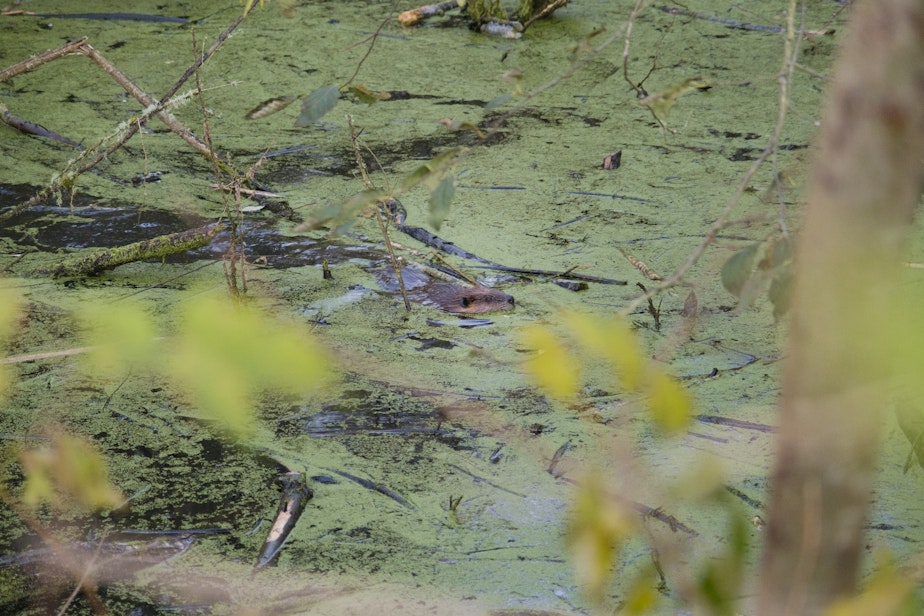
Seattle Parks & Rec has a “really hard path to walk” to determine the right way to balance the needs of salmon, beaver and humans at the park, Kerr said.
It also appears that the city may have misinterpreted the law governing beaver dam modification.
As spawning season continued and more fish failed to overcome the beaver dam, David Koon of Carkeek Watershed Community Action Project kept asking for an intervention.
“I'm saying let's not touch the dam,” Koon said last week. “But let's do something about the human element that has made the dam a bigger problem.”
His communication with the city had slowed to a trickle. Officials did not want to talk about the damned beavers. And besides, the state would not allow changes to the dam during salmon spawning season anyway – right?
Actually, that turned out to be wrong – as KUOW found out with a call to state Fish & Wildlife.
“Yes this is a beaver dam that is getting a lot of attention. And that's okay,” Stewart Reinbold said with a laugh.
Reinbold is the King County district habitat biologist for Washington Fish & Wildlife, and he’s worked on countless beaver dam situations in his more than 20 years with the department.
“It's very rare that a beaver dam will actually stop salmon migration. It's happened a few times,” Reinbold said.
“Beavers and salmon have worked together and coexisted for thousands of years,” he added. “We want people to realize that we're part of a bigger ecosystem, and we can work together and respect each other's roles.”
But the state does not tie Seattle’s hands in this matter, as the city’s statement claimed.
Since 2019, Seattle has had a multi-site Hydraulic Project Approval permit that allows for actions like modifications to a beaver dam after consultation with state Fish and Wildlife experts.
“So they actually already have something they can use,” Reinbold confirmed. In a follow-up email, he said the city’s position was a “misunderstanding.”
On Friday, shortly after KUOW’s interview with Reinbold, Seattle Department of Parks and Recreation spokesperson Rachel Schulkin sent an email:
“We were able to get on the same page with [WA Fish & Wildlife] and are now permitted to make small changes to the existing dam,” Schulkin wrote, adding later, “there are plans to make changes in coming days.”
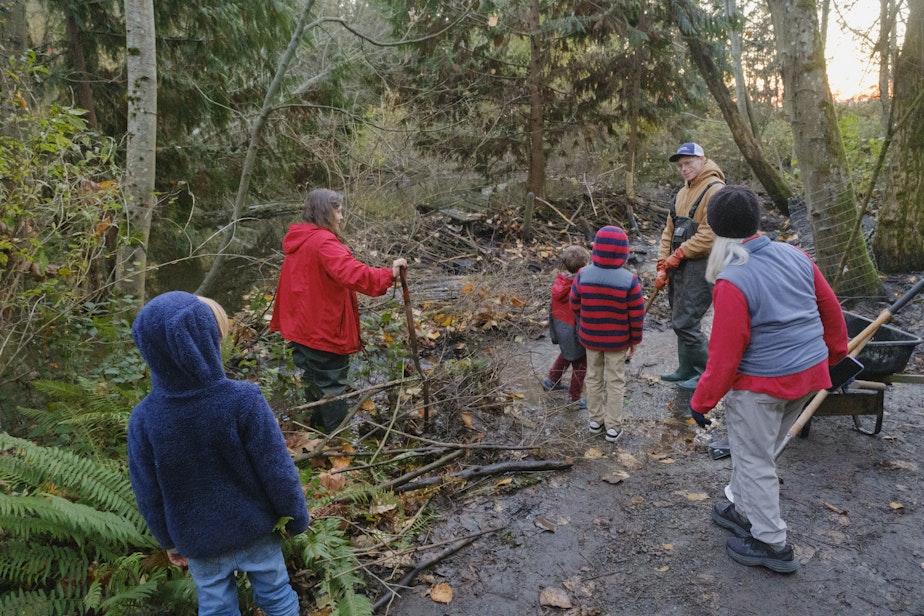
That afternoon, as the sun was dipping low, two Parks and Rec employees in rubber boots and work gloves were down at Piper’s Creek, shovels in hand, widening a small channel on the North side of the dam – a pathway for the salmon to swim around the dam.
David Koon was with them, carefully removing parts of the hard-packed gravel he’d been eyeing for weeks.
“I think this will give them a good shot,” he said, a note of cautious optimism in his voice. “Yeah, I think. We'll see.”
In the days following, Koon reported having to clear some leaves and sticks from the newly formed channel, as beavers worked overnight to block it up. He also said he watched more than a dozen salmon fight their way past the dam, on their way to spawn upstream.
[NOTE: If you want to see the beaver dam and salmon up close at Carkeek Park, chum spawning season continues through mid-December]





